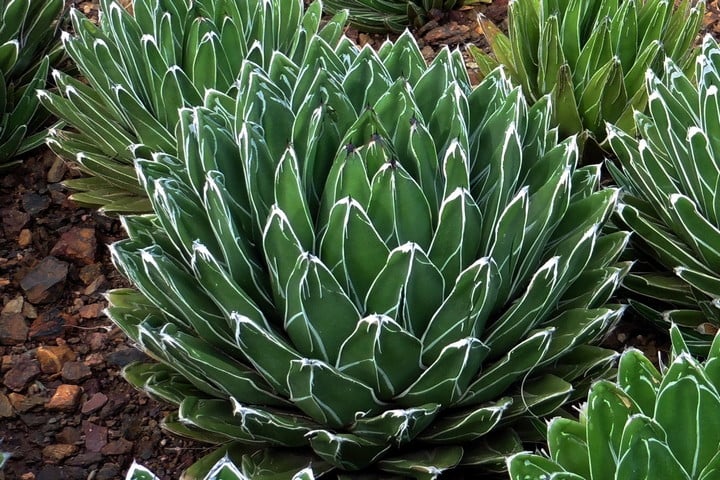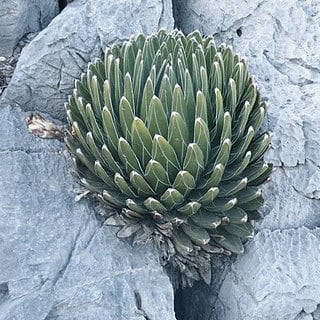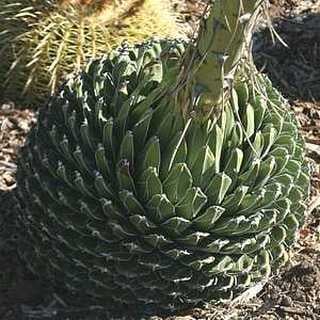Queen Victoria agave is widely considered one of the most attractive agaves — one that’s truly “fit for a queen”. Here’s everything you need to know about planting and taking care of this Chihuahuan Desert native, whether you grow it in a container or plant it in the ground.

Queen Victoria agave (Agave victoriae-reginae) is one of the most distinctive small agaves. It’s short, chunky, dark green leaves are lined with noticeable white margins and form tight, symmetric rosettes.
Plant this stunner where it’s exquisite details can be admired up close — in a container or as a small accent plant in a rock garden.
Queen Victoria agave is as close to “no maintenance” as a plant can be. It doesn’t need pruning, needs minimal water, and doesn’t produce litter.
It’s very long-lived and slow-growing, so you can expect to have it for many years and it should never outgrow its its space.
Why I Like This Plant
- Looks stunning all year
- Eye-catching rosettes with white margins
- Extremely hardy, low-maintenance
Things to Watch Out For
While its leaves have smooth edges, they are tipped with a single short spine.
Agaves contain compounds that can cause a rash called agave dermatitis in some people.
This agave is small and expensive, so avoid planting where it may be trodden on by people, pets, or wildlife.
Optimal Growing Conditions
If you’re thinking of adding a Queen Victoria agave to your garden, you need to find a suitable place that will keep your plant healthy and looking good… while minimizing maintenance for you.
Here are the key factors to keep in mind.
Temperature
Queen Victoria agave should be grown in USDA Hardiness Zones 9 – 11. It can take both extreme heat and cold, surviving temperatures down to 10℉.
Sun Exposure
Queen Victoria agave thrives in full sun, but appreciates some afternoon shade in the hottest areas.
Size and Growth Rate
Queen Victoria agave is very slow growing and ultimately reaches a mature size of only one to two feet tall and wide, but it can take many years to reach this size.
This agave is particularly long-lived and can live anywhere from 15 to 40 years.
At the end of its lifecycle, it will send up an impressive flower stalk and then die. Flower stalks grow fast, reaching a height 10 to 15 feet. This is an amazing feat for a plant of this size!
Soil
In its native habitat, Queen Victoria agave grows on rocky limestone slopes. In the garden, it prefers dry, rocky, limestone-rich soil. Good drainage is essential to avoid root rot.

Other Location Considerations
Queen Victoria agave makes an excellent container plant. Make sure your pot has adequate drainage holes and use specifically formulated cactus soil. And be sure not to overwater.
Queen Victoria Agave:
The Essentials
| Common Name | Queen Victoria agave |
| Scientific Name | Agave victoriae-reginae |
| Origin | Mexico |
| USDA Zones | Zones 9 – 11 |
| Cold Hardiness | To 10℉ |
| Mature Size | 1-2′ high x 1-2’ wide |
| Growth Rate | Slow |
| Sun Tolerance | Full, part sun |
| Water Needs | Low |
| Pests & Diseases | Root rot if overwatered |
| Cautions | Agave dermatitis, spines |
| Wildlife | Deer resistant |
How to Plant
Dig a hole as deep as and twice as wide as the nursery container. Carefully remove the plant from the container, put it in the hole, and fill with the same native soil you just removed. Press the soil to remove any air pockets.
Never plant deeper than the depth of the root ball which can cause rot. Actually, it’s best to plant an inch or two above soil level to give the plant room to settle and leave room for mulch.
It’s generally recommended that you not add amendments to the soil. However, good drainage is critical, so if your soil drains slowly, amend with coarse sand or small gravel until you have a loose, well-drained mix.
When to Plant
The best time to plant agaves is in April and May. The warm temperatures of spring encourage root development. The second best time is in late summer or early fall when temperatures are still high.
How to Care for Queen Victoria Agave
Whether you’ve recently planted a Queen Victoria agave or have an existing plant in your yard, here’s how to take care of it to keep it healthy and looking its best.
How to Water
You’re probably used to giving a plant a good soaking immediately after transplanting, but that isn’t the best practice with agaves.
Counterintuitively, it’s best to not water agaves for one to two weeks after planting. Then use the following schedule as a guide.
| Spring & Fall | Every 3-5 weeks |
| Summer | Every 2-4 weeks |
| Winter | Only if no winter rains |
Once established, water once a month in the summer and not at all during the winter. Water sparingly helps these plants keep their tight form.
If you’re growing your agave in a container, use this watering schedule as a guide.
| Spring & Fall | Every 7-10 days |
| Summer | Every 5-7 days |
| Winter | Every 10-14 days |
Should You Fertilize?
There is no need to fertilize Queen Victoria agave, these plants evolved to thrive in poor desert soil.
If you grow one in a pot, fertilize lightly once a month spring through summer.
Pruning & Propagation
Queen Victoria agave should not be pruned except to remove dead or damaged lower leaves.
Some plants grow as a single rosette, while others produce offsets or pups. If yours produces pups, all you have to do is dig them up, making sure that some root remains intact, and plant them elsewhere.
Note that some plants produce copious number of offsets. If that’s the case with yours, you may want to thin them out occasionally.
Pests
Agave snout weevil is an insect that can attack any agave, but fortunately, Queen Victoria agave is less susceptible than many agave species.
Queen Victoria Agave Cultivars
There are several Queen Victoria cultivars on the market that you may come across when plant shopping.
Agave victoriae-reginae ‘Porcupine’ has very thick leaves and is particularly slow-growing and compact, making it a good choice for containers.
Agave victoriae-reginae ‘Compacta’, as the name implies, is another compact cultivar. You can see in the picture below that it grows almost as a sphere.

Plant Lover Facts
Queen Victoria agave also goes by the name royal agave. The British botanist Thomas Moore named this plant in honor of Queen Victoria.
It’s native to the dry lower elevations of the Sierra Madre Oriental mountain range in northeastern Mexico, where it grows almost exclusively on rocky canyon slopes.
I’ve read repeatedly that while this plant is very common in cultivation, it’s endangered in the wild. But according to the International Union for Conservation of Nature, it’s not endangered and is currently in their “least concern” category.
Did you enjoy this article?
Sign up for our weekly newsletter
where you’ll find more great info on creating &
maintaining a beautiful, carefree desert landscape.
Author Bio
Deane Alban is the creator of Southwest Gardener. She is a science writer with a bachelor’s degree in botany from the University of South Florida. Gardening is her lifelong passion. She’s been gardening in Tucson for over 15 years.

Photo Credits
Arizona State University’s Virtual Library of Phoenix Landscape Plants
Amante Darmanin, CC BY-SA 2.0, via Wikimedia Commons
